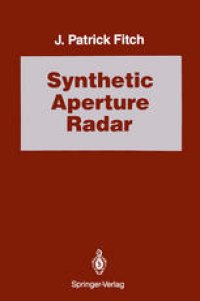
Ebook: Synthetic Aperture Radar
Author: J. Patrick Fitch (auth.)
- Tags: Communications Engineering Networks
- Series: Signal Processing and Digital Filtering
- Year: 1988
- Publisher: Springer-Verlag New York
- Edition: 1
- Language: English
- pdf
Radar, like most well developed areas, has its own vocabulary. Words like Doppler frequency, pulse compression, mismatched filter, carrier frequency, in-phase, and quadrature have specific meaning to the radar engineer. In fact, the word radar is actually an acronym for RAdio Detection And Rang ing. Even though these words are well defined, they can act as road blocks which keep people without a radar background from utilizing the large amount of data, literature, and expertise within the radar community. This is unfortunate because the use of digital radar processing techniques has made possible the analysis of radar signals on many general purpose digi tal computers. Of special interest are the surface mapping radars, such as the Seasat and the shuttle imaging radars, which utilize a technique known as synthetic aperture radar (SAR) to create high resolution images (pic tures). This data appeals to cartographers, agronomists, oceanographers, and others who want to perform image enhancement, parameter estima tion, pattern recognition, and other information extraction techniques on the radar imagery. The first chapter presents the basics of radar processing: techniques for calculating range (distance) by measuring round trip propagation times for radar pulses. This is the same technique that sightseers use when calculat ing the width of a canyon by timing the round trip delay using echoes. In fact, the corresponding approach in radar is usually called the pulse echo technique.
This book provides a clear and concise introduction to radar signal processing for nonspecialists - those who want to perform image enhancement, parameter estimation, pattern recognition, and other computer-based information extraction techniques on the radar imagery as well as cartographers, agronomists, and oceanographers. Four chapters lead the reader through the basics of radar processing, providing a thorough explanation of how to combine one dimensional radar returns into two dimensional images, a discussion of synthetic aperture radar (SAR), its optical interpretation and implementation, and an overview of other image reconstruction algorithms including tomography and ultrasound. End of chapter problems together with solutions make this volume ideal for a course on imaging systems and techniques.
This book provides a clear and concise introduction to radar signal processing for nonspecialists - those who want to perform image enhancement, parameter estimation, pattern recognition, and other computer-based information extraction techniques on the radar imagery as well as cartographers, agronomists, and oceanographers. Four chapters lead the reader through the basics of radar processing, providing a thorough explanation of how to combine one dimensional radar returns into two dimensional images, a discussion of synthetic aperture radar (SAR), its optical interpretation and implementation, and an overview of other image reconstruction algorithms including tomography and ultrasound. End of chapter problems together with solutions make this volume ideal for a course on imaging systems and techniques.
Content:
Front Matter....Pages i-viii
Radar Processing....Pages 1-32
Radar Imaging....Pages 33-83
Optical Processing of SAR Data....Pages 85-108
Related Algorithms: An Overview....Pages 109-130
Back Matter....Pages 131-170
This book provides a clear and concise introduction to radar signal processing for nonspecialists - those who want to perform image enhancement, parameter estimation, pattern recognition, and other computer-based information extraction techniques on the radar imagery as well as cartographers, agronomists, and oceanographers. Four chapters lead the reader through the basics of radar processing, providing a thorough explanation of how to combine one dimensional radar returns into two dimensional images, a discussion of synthetic aperture radar (SAR), its optical interpretation and implementation, and an overview of other image reconstruction algorithms including tomography and ultrasound. End of chapter problems together with solutions make this volume ideal for a course on imaging systems and techniques.
Content:
Front Matter....Pages i-viii
Radar Processing....Pages 1-32
Radar Imaging....Pages 33-83
Optical Processing of SAR Data....Pages 85-108
Related Algorithms: An Overview....Pages 109-130
Back Matter....Pages 131-170
....